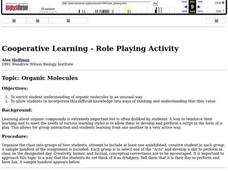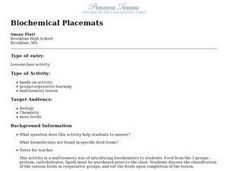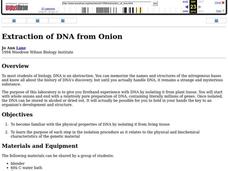Curated OER
Organic Molecules
Students explore organic compounds. Using humor, factual and conceptual correctness, students create a skit explaining organic compounds. Students include topics such as sugar, polymerization, unraveling of proteins, and substrates. ...
Curated OER
Structural Changes in a Protein
Pupils observe and manipulate the structure of a protein. They form an alpha helix, a beta sheet, and add disulfide bonds. They create a multimeric protein and compare their location with other students.
Curated OER
Biochemical Placemats
Students group various foods according to whether they are proteins, carbohydrates, or lipids. This activity is a multisensory way of introducing students to biochemistry. Students also learn how icons represent the molecular composition...
Curated OER
Molecular Structure of Proteins
Students examine the effects different substances have on proteins. They test different molecules reaction to water. They discover how the amount of water affects the shape of the protein.
Curated OER
The Structure And Functions of Proteins
Ninth graders investigate the structure of proteins and how it affects their function. They build a protein model with four helix units and describe how this structure aids the protein in doing its jobs.
Curated OER
Building a Better Body
Fourth graders investigate the six essential nutrients. They read a handout, discuss the six nutrients, and construct a sandwich using ingredients that belong to the nutrient groups.
Curated OER
Diet and Nutrition
Young scholars figure out the nutritional values of foods to explain the nature of a healthy diet by looking at fast food nutrition pamphlets and calculating the values of foods then comparing them to the food pyramid.
Curated OER
Who Stole My Salad?
Eighth graders explain how protein is made in the cell. In this biology lesson, 8th graders translate RNA and DNA using an internet database. They determine the thief based on evidence collected.
Curated OER
Carbohydrates, Proteins, and Fats
Young scholars describe the properties of carbohydrates, proteins and fats. In this health science lesson, students identify food sources where these nutrients can be found. They explain how they affect our body.
Curated OER
MacroMolecules
This single slide displays the discussion points to differentiate between the main molecules ; structure/function/classes/lab test/common examples
Curated OER
Nutrient Biochemistry
In this proteins learning exercise, students review how amino acids are sequenced to determine types of proteins. Students also review how proteins are used by the body. This learning exercise has 2 drawing and 24 fill in the blank...
Curated OER
Cell & Developmental Biology
In this biology activity, learners identify and locate various vocabulary terms related to cells and developmental biology. There are 54 biology terms located in the word search.
Curated OER
PLO A Word Search Puzzle
In this science worksheet, middle schoolers look for the solutions to the word search while focusing upon the vocabulary that is related to lipids and proteins.
Curated OER
Protein Exploration
Twelfth graders examine protein shapes through a computer program that can be downloaded off the Internet. The program allows students to see how proteins look when viewed with X-ray crystallography.
Curated OER
Extraction of DNA from Onion
Pupils experiment with DNA by isolating it from plant tissue. They investigate whole onions to prepare DNA. They complete the experiment to examine the structural characteristics of DNA.
Curated OER
Proteins Expressed At Different Stages
Students investigate protein electrophoresis in a lab setting. Full laboratory equipment is needed and safety should be taught. The level of prior knowledge needed to perform lab is high and is ideal for an honors class.
Curated OER
Teaching Students How to Read the Protein Concentration in a Sample
Students work together to identify proteins in different samples. They calculate the protein concentration in those samples as well. They complete discussion questions to end the lesson.
Concord Consortium
Concord Consortium: Stem Resources: Molecular Self Assembly
A series of science simulations exploring how molecules assemble themselves and how scientists are learning to engineer their structure. Students will discover what patterns molecules form with interactive lessons. At the end there is a...
Concord Consortium
Concord Consortium: Stem Resources: Protein Partnering and Function
A learning module with built-in interactive features where students can read about the differences between large and small molecules, build protein structures, and test their strength under different conditions. They will review polarity...
Concord Consortium
Concord Consortium: Science of Atoms and Molecules: Nucleic Acids and Proteins
Through this activity, students work with macromolecules, proteins and nucleic acids. The focus is on the atomic structure of proteins, how linear polymers are made, and the surface charges of the resulting polymers. . Multiple-choice...
Cold Spring Harbor Laboratory
Dna From the Beginning
At DNA from the Beginning, choose from classical genetics, molecules of genetics, genetic organization and control. Each concept is explained through animation, an image gallery, video interviews, biographies and links.
eSchool Today
E School Today: Your Revision Notes on the Nutrients in Food
Discusses food, why we need it, and the types of nutrients that food for humans must have.
University of Arizona
The Biology Project: Immunology: Introduction to Western Blot Activity
Simulate the Western blotting procedure used to identify specific amino-acid sequences in proteins.
PBS
Pbs Learning Media: How to Conquer a Genetic Disease
In Blazing a Genetic Trail, by the Howard Hughes Medical Institute, follow this three-step approach to treating genetic diseases.
























